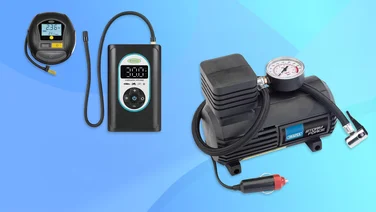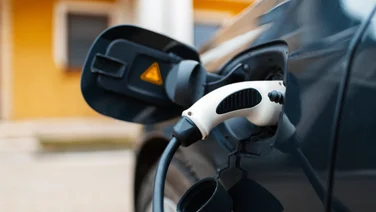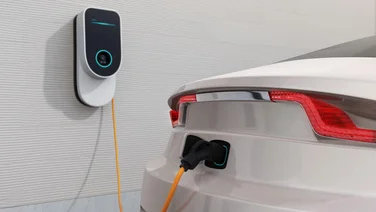To help us provide you with free impartial advice, we may earn a commission if you buy through links on our site. Learn more

Install an EV charger at home and it becomes perfectly possible to charge an electric car or van cheaply, conveniently and without the need to queue for hours.
It won’t be an exceptionally fast charge, but in truth it doesn’t really matter: you can get home from work, plug in, and by the time you’ve finished your Weetabix the next day, it’s highly likely you’ll have a full battery. And that means that many cars will have the ability to travel more than 300 miles. Every morning. And without the need for a pitstop for a tank of unleaded or diesel.
If you only travel a few miles a day to work, the shops or to ferry the kids to school – as many of us do – it’s entirely possible that you’ll only need to charge once a week, or even less. The reassuring idea of having a ‘full tank’ every morning is a key reason why people choose an EV.
Depending on your electricity tariff and the size of your car’s battery, a full charge could cost less than £20. Of course, using a high-speed public charger will get you charged quicker, and may be essential on a long road trip, but it will also cost you more – much more in some circumstances. At home, you’ll never pay more than the electricity price cap.
With that in mind, you can use our free price comparison tool to get a quote directly from a supplier near you.
Here’s how to install an EV charger at home and take advantage of the many benefits.
Get a free quote for home EV charger installation now
Save yourself some time (and potentially money) by taking our quick survey below – we’ll provide a quote for EV charge point installation that matches your needs.
How much does it cost to install?
As with so many household jobs, the cost of installing an EV charger depends on how complex it is. As a very rough guide, you can expect to pay between £600 and £1,000 to have a charger supplied and fitted. For that, you’ll have something that charges up to 7kW, and will be operated through a smartphone app.
Of course, there’s more to it than just that; for more information, see our full guide to costs below.
READ NEXT: How much does it cost to install a home EV charger?
Are there any EV wallbox grants available?
Sadly, if you’re a homeowner you’ve missed the boat, because the old Electric Vehicle Homecharge Scheme used to cover a substantial part of the installation costs for most homeowners.
In 2022 it was replaced by the EV Chargepoint Grant which is aimed at those who own and live in a flat, or those who rent a residential property. Assuming you have private off-street parking, and you own an eligible vehicle, you could receive £350 or up to 75% of the cost to buy and install a charger.
The rules in Scotland are different. EV owners who live in rural and remote locations, and those who’ve bought a used EV through the Scottish government’s Used Electric Vehicle Loan Scheme may be eligible for a £300 wallbox grant.
Looking to find out how much a home EV charger could cost?
Find the best supplier for you
Where should I put my EV charger?
It sounds obvious, but you’ll want to have your charger installed as close to your home’s parking space as possible to avoid wires trailing across the path to your front door. It’s worth giving thought to which side your car’s charging port is located, and whether you need to park nose-in or are able to reverse park. But the reality is most charging cables are long enough to reach, and after a few parking attempts, you’ll know intuitively where you need to stop.
For the easiest – and cheapest – installations, you’ll want to be fairly close to your home’s electricity meter. The installer will drill a hole through the wall, and run armoured cable along the length of your house to the wallbox. Of course, it’s possible to hide cabling, but the more work that’s involved to conceal, the more it’ll cost.
It’s possible to have home wallbox chargers installed in your garage, car port or in or on outbuildings. Just remember that armoured cables are expensive, and so is the cost of digging trenches or lifting floorboards to conceal it all.
If you buy your home EV charger from a brand like Hive, PodPoint or BP Pulse, they will talk you through the process, providing guidance once you’ve bought the charger. You might need to talk them through your situation on the phone, and they will look at your house using Google Maps or request photographs of your house and your electricity meter.
If you use a local installer to supply and fit, they will be able to talk you through the process in person, as they would with any other electrical job.
There are rules governing the positioning of wall boxes. It will need to be at least 2.5 metres from any metal devices you have around your house. It must be more than two metres from a public road or a listed building.
Looking to find out how much a home EV charger could cost?
Find the best supplier for you
Are all electric car chargers the same?
Fundamentally, home electric chargers are simply a box with a socket or lead that screws on your wall. They all have a Type 2 plug, which is used by the vast majority of EVs, and are all built to withstand poor weather, extremes of temperature and the occasional bit of rough handling.
Few wallboxes are particularly stylish, but if you’re looking for one to install on your own Grand Design, then consider Andersen, which features more attractive designs than most. Some wallboxes have a screen on the unit, but most use an app allowing you to schedule charging, and monitor the charge state and the cost of electricity.
More pragmatically, you’ll need to decide what power rating you want. The vast majority of home EV chargers can deliver around 7kW (kilowatts), which is the maximum you’ll get from the single-phase power supply most homes have. If you’re lucky enough to have three-phase power, you can get wallboxes that deliver up to 22kW. For a slower charge, 3kW wallboxes are available, but here you’re charging only a little faster than you would from a three-pin plug – all you’re really getting is the convenience of being able to plug in close to your car.
Another consideration is whether you want your wallbox to have a cable attached or not. Tethered wallboxes have their own cable attached; untethered wall boxes require you to plug a cable in each time. The choice is down to personal preference, but tethered chargers are more convenient because you don’t need to get your own cable out of the boot each time, but untethered wallboxes look neater.
READ NEXT: The best home EV chargers available now
How much does it cost to run?
The costs involved in using a wallbox are governed by your home electricity supplier rather than the wallbox itself.
At the time of writing, there are a tiny handful of specialist EV tariffs on the market, and even fewer that are worth switching to right now. The situation is constantly evolving, so if you’re planning your first EV purchase, it pays to shop around for the best electricity tariff more than ever.

If you have a dual-rate meter, you should be able to benefit from cheaper overnight charging. You can schedule this from the infotainment system in most EVs, or through the companion app. You may also be able to schedule through the wallbox’s own app, too.
To calculate the cost of your charge, look at your energy statement to find out how much you’re paying per kilowatt, then multiply that by the size of your car’s battery.
So, at the current electricity price cap of 34 pence per kilowatt, it’ll cost £14 to charge a Nissan Leaf’s 40kWh battery from empty to full, or about £20 to charge the Tesla Model 3’s 60kWh battery to maximum. Remember, in the same way petrol cars are rarely filled from completely empty to full, it’s likely you’ll only be making a partial charge.
In the same way that miles per gallon is arguably more important than the cost of petrol per litre, the cost per mile – or miles per kilowatt hour – is important for EVs. This is the measure of your car’s economy, and will be influenced by how and where you drive, as well as the outside temperature – EVs are far more efficient in warmer weather than they are in the depths of winter.
To find this out, have a look at a range of online car reviews for the miles/kilowatt hour figure – often shortened to mi/kWh.
Looking to find out how much a home EV charger could cost?
Find the best supplier for you
How long does it take to charge an electric car at home?
The length of time to charge is one of the first questions asked, but also one of the hardest. Unlike petrol or diesel, which is governed by the size of your fuel tank and the number of miles you want to drive before the next fill up, EV drivers need to understand the rate of charge. Or to put it in terms of conventional fuels, the size of the pump or the diameter of the fuel hose – things that simply aren’t considerations.
You’ll find estimated charging times in your car’s handbook. As an illustration, to charge a Tesla Model 3 from 0-100% using a 3kW charger will take 15-22 hours, compared to 8-12 hours from a 7kW charger. A 22kW charger would cut this to between 5-8 hours.

Another thing to consider is that depending on other appliances you’re running at home, you might find you’re not getting the full rate of charge. To avoid blowing fuses, many wallboxes will throttle back the rate of charge delivered if you’re using other power-hungry kit, such as a hot tub.
But for many drivers, the time it takes to charge their EV at home is largely moot, because higher mileage drivers will quickly get into the habit of charging every evening regardless of how much juice is in their car’s battery.






